Introduction
Research Background
Traditional marketing communication strategies thrived on a one-way street enabled by television, print, and radio. This time, it has assumed two-way street with online marketing communications. Often referred to interchangeably with terms like e-marketing and the more recent phenomenon of social media marketing, online marketing communications has increasingly focused on the advertising potential of social networking and collaborative media sharing in increasing retail sales (Stokes 19). With the rapid modernization, the use of technology and information systems is also increasing in marketing. Therefore, it is important to review the impacts of electronic word of mouth (eWOM) on purchasing behavior with reference to customers in Saudi Arabia.
Saudi Arabia has quickly embraced the e-marketing strategies to be at par with other countries. In the last two decades, e-marketing has played a key role in product promotion in nearly all sectors. The most common e-marketing platforms in Saudi Arabia include social media, the internet, and cable television. This paper will attempt to establish the actual impact of electronic word of mouth on Saudi customers’ purchasing behavior.
Research Problem Statement
Economic and social responsible purchasing behaviors of consumers have become significant determinants of consumer behavior. Analysis of consumer behavior is carried out in a systematic manner using various consumer behavior theories and models. Consumer behavior theories have been applied to study consumer behavior; however, gaps still exist between the traditional and contemporary consumer behavior that warrant further studies. Consumers are generally influenced by two factors: internal influences and external influences. Internal influences are personal feelings and thoughts that include self-concept, motivation, attitudes, emotions, and perceptions (Stokes 56).
The personal feelings are often influenced by external factors such as advertisement methods. For instance, e-marketing has an influence on perception, purchasing patterns, and attitude customers develop toward a product or a service offered by the business. Reflecting on internal and external influences, it is important to establish the actual relationship between electronic word of mouth and consumer purchasing behavior among the Saudi Arabians. Thus, the findings and recommendations at the end of this study may give insight into the actual impact of electronic word of mouth on purchasing behavior. Companies may use the findings to properly design the electronic word-of-mouth advertisements to enhance product acceptance.
Research Hypothesis
- H1o: The electronic word-of-mouth advertisement has an impact on consumer purchasing behavior among the Saudi Arabians.
- H1a: The electronic word-of-mouth advertisement does not have an impact on consumer purchasing behavior among the Saudi Arabians.
- H2o. There is a link between the level of product satisfaction and acceptance of electronic word-of-mouth communication.
- H2a. There is no link between the level of product satisfaction and acceptance of electronic word-of-mouth communication.
- H3o. There is a link between the type of message in an electronic word-of-mouth communication and probability of purchase for such an item in Saudi Arabia.
- H3a. There is no link between the type of message in an electronic word-of-mouth communication and probability of purchase for such an item in Saudi Arabia.
- H4o. Consumer purchasing behavior as influenced by an electronic word-of-mouth communication is dependent on the level of trust and knowledge customer has for the company selling a product.
- H4a. Consumer purchasing behavior as influenced by an electronic word-of-mouth communication is not dependent on the level of trust and knowledge customer has for the company selling a product.
The Research Aims and Objectives
The paper explores the extent and nature of electronic word of mouth as a marketing strategy to determine an overall assessment of the value of this strategy on purchasing behavior among consumers in Saudi Arabia. The purpose of this research is to assess the effectiveness in attracting customers to purchase by using online marketing communication tools. In order to answer the research problem, the author will describe the electronic word of mouth from the consumer’s perspective. In more specific terms, the research will have the following as its main objectives:
- The most pervasively electronic word of mouth that businesses use to market their products to their target customers in Saudi Arabia.
- How customers perceive the electronic word of mouth over the internet in terms of its advantages and disadvantages in their purchasing behavior.
- The electronic word-of-mouth experience and how it has increased or decreased the purchasing patterns among customers in Saudi Arabia.
Research Questions
- How effective is the electronic word of mouth on the orientation of different product intake in Saudi Arabia?
- What is the relevance of the electronic word of mouth on different perceptions towards products in Saudi Arabia?
Significance of the Study
Several studies have been carried out on the role that online marketing plays in increasing retail sales. However, no such study has been done particular focusing on internet marketing through the electronic word of mouth and its impact on purchasing behavior in a specified market of Saudi Arabia. This paper extensively analyses primary and secondary data from various sources to illustrate online buyer behavior as influenced by the electronic word of mouth and draw scientific conclusions on the opportunities that internet marketing offers to different companies in Saudi Arabia. To provide a broad solution for electronic word of mouth marketers in Saudi Arabia, the study goes ahead to illustrate the impact different online communication tools have on retail sales.
Limitations of the study
The limitation of this study is to focus only on the attracting effort of online marketing strategies. That’s why the main focus of this research will be on the marketing communication efforts to influence customers to purchase different products in Saudi Arabia. Besides, the focus of the paper is narrow because a sample of 200 participants may not represent the accurate summary of the impact of the electronic word of mouth on customers’ purchasing behavior in the entire Saudi Arabian market. It is very hard to understand how a convenience sample is representative of the population. Using respondents on the basis of their availability may leave out some respondent who would add value to the research. The final limitation of this study is the scarcity of resources. The available finances could not allow the researcher to increase the sample size and improve the ‘representativeness’ of the sample.
Literature Review
General Factors Influencing Consumer Purchasing Behavior
Consumers are generally influenced by two factors which include internal influences and external influences. Internal influences are personal feelings and thought that includes self-concept, motivation, attitudes, emotions and perceptions. These factors generally influence perception, purchasing patterns, and attitude customers develop toward a product or a service offered by the business. Besides, these factors are directly linked to internal and external interacting social aspects that control the pattern of thought and expressed feelings.
Internet Marketing Communication in Saudi Arabia
Geld and Sundaram (2002) state that “the current clutter on the internet virtually ensures that the ‘build it and they will come’ model is insufficient to draw consumers, marketers need to actively attract users in the first place” (Gelb and Sundaram 23).
Online marketing is much more complicated and planned communication activity rather than just putting an online advertisement. Companies may have great content, dynamic and attractive designs on their website, but the customer may not be aware of that website because of wrong or inadequate electronic word of mouth. That is why companies must start their online marketing strategy by focusing on attracting visitors to the company’s website in firsthand. Almana and Mirza (2013) state that “before an organization can acquire customers through the content on its site, it must, of course, develop marketing communication strategies to attract visitors to the website” (Almana and Mirza 26). Marketing communications through the electronic word of mouth started to take an active role in marketing activities of companies during the beginning of the last decade.
Specifically, under the operational process of online marketing, electronic word-of-mouth communication is among the modern marketing strategies that are widely used for marketing in most enterprises in Saudi Arabia. This can be defined as the utilization of the internet in transferring product related information from the organization to the target market (Gelb and Sundaram 23). Internet marketing communication comprises of two main components which include how the internet enables online branding and communication. There is an immense need for enterprises to have a deep understanding of the role that electronic word of mouth has in enhancing sales across different sectors in Saudi Arabia. Most individuals visit the internet in search for product information. Organizations require a clear understanding of how to utilize the Internet in effective marketing communication (Stokes 32).
The quality of internet marketing in the form of electronic word of mouth within the enterprise determines the level of organizational performance and its competitive advantage. At the same, time the internet marketer can analyze their online customers through the way they interact with the brand online since the electronic word of mouth has direct influence on customer purchasing behavior (Khammash and Griffiths 91). Internet marketing communication in the form of the electronic word of mouth allows enterprises to reach out to the target market on a real time basis.
Consumer Behavior Theories
As opined by Stokes (2011), rationality in purchasing is influenced by awareness of different options available in order to maximize gain from every bundle of purchases made. From these numerous options, the rational customer will correctly rate the best and will be in a position to pick the one with the highest level of satisfaction from the information communicated through the electronic word of mouth. Similar as satisfying and Tversky’s Prospect theories, satisfaction and perception of the same is the driving force behind the purchasing patterns of different consumers in different market settings with reference to electronic word of mouth (Stokes 45). Thus, the rationality to adopt or reject a product is solely determined by the satisfaction level as perceived by that particular customer through the message within the electronic word of mouth message.
On the other hand, the psycho-dynamic consumer behavior approach posits that ‘drives’ or ‘instinctive forces’ influence the decision to purchase or reject a product. As opined by Khammash and Griffiths (2011), these external drives operate outside the individual’s conscious thought. This approach supports the three psyche facets of ego, ID, and superego that is often controlled by the unique cultural orientation, religion, and thought matrix of an environment. Thus, environmental stimuli are the driving force for a particular behavior of consumers. Since man is a cognitive being, the theory concludes that the interpersonal stimulus events will be the primary and causative determinants of an overt purchasing behavior. For instance, the message within the electronic word of mouth has direct influence on purchasing behavior since customers will relate the message to the satisfaction level of a particular product (Khammash and Griffiths 95).
According to Stokes (2011), repertoire and subscription markets control customers’ loyalty to a brand. Reflectively, the authors assert that consumers’ repeated purchasing as behavior is influenced by the ability of marketers to develop a middle action level between repertoire and subscription markets. Reflectively, this aspect allows for insightful gain in customer loyalty behavior through appropriate electronic word-of-mouth marketing (Stokes 51).
The emotional perspective of consumer behavior represents an effective view on consumer behavior. For example, emotions are caused by exposure to a particular stimulus. Emotion is positively related to consumer attitude. This is the general evaluation that consumers engage in before deciding to purchase a product. Attitudes are direct personal experiences that are influenced by consumers’ personalities, advertisements, family, and friends. Specifically, Saudi Arabians are known for their unique culture of embracing products that appeal to family values since their purchasing behavior is often influenced by external factors and general perception (Khammash and Griffiths 89). Therefore, a properly presented electronic word-of-mouth message that includes the Saudi cultural aspects will eventually influence product intake.
Consumer Behavior and Perception
According to Weiss (2008), consumer behavior on the purchasing and the perception of a brand is determined by advertising through appealing to ideal and catchy words that are easy to interpret. In union with my previous assumption, the author states that emotional branding determines the overall perception and purchasing behavior since most consumers would prefer to be identified with then ideal fad or fashion. Therefore, marketing strategy as part of consumer behavior analysis should be aligned to the ideal as perceived by consumers. Generally, the catchier an advertisement is, the higher chances of uptake. On the other hand, less catchy advertisements may not work well with consumer perception of such brands. Saudi Arabian consumers are known to embrace brands that appeal to perception (Weiss 32). This means that an effective electronic word-of-mouth communication will directly influence their purchasing behavior.
The Buying Decision
There has been substantial research on consumer behavior, examining the decision process and influences upon it. These are in terms of store, brand characteristics, and consumer behaviors. “Central to the theories of consumer behavior is the conviction that different consumers go through markedly complex decision-making process that is influenced at different stages by a number of possible variables,” (Hennig-Thurau et al. 41).
The buying process normally begins with the need for a particular product or good. The ‘need recognition’ by consumers is an essential part of the buying process because purchase cannot take place without it. The second stage in the decision-making process is ‘information search’. The need that is created prompts a consumer to search for available information concerning the good or service that can satisfy that need. Information search occurs internally and externally. The internal examination involves searching for information from the memory of the consumer and is majorly determined by past experiences with such products. External search is employed when the internal search fails to provide the information necessary to help the consumer make the buying decision in Saudi Arabia (Stokes 29). A well-presented electronic word of mouth has a direct impact on product intake.
Methodology
Collection of Data
The research made use of both secondary and primary methods of data collection. The main sources of secondary information for this research were books, journals, and online articles. It was imperative for the researcher to find out the views of other scholars given the limited primary data. These secondary sources were essential in generating strong theory and literature in the study (Yin 21). The main sources for journal articles in this research were books and online journal databases. These secondary sources were used to gather insights on online marketing communication. This includes the characteristics and techniques of online marketing communication in the form of the electronic word of mouth within organizations in Saudi Arabia and their influence on customers’ purchasing behavior.
The research also made use primary sources of data collection. The main objective of these primary sources was to maintain the validity and reliability of the research. The term reliability is a measure of consistency that ensures that the test produces similar results repeatedly. The researcher used close-ended questions in order to enhance the reliability of the survey. On the other hand, validity in research refers to how the test measures the intended objectives accurately. The researcher had to enhance the validity of this survey by pre-testing the questionnaires and correcting any inconsistencies within the questions. Primary data minimizes the possibility of any ambiguous data getting their way into the research. Primary data also assist in generating the empirical base of the survey (Yin 31).
The respondents were given questionnaires that had close-ended questions. In this research, all the questionnaires were sent forty respondents, via email, who are active online purchasers in Saudi Arabia. Most of the target respondents have an easy access to the internet. This was vital in determining the trends of Internet marketing communication techniques in the form of electronic word of mouth and its impact on consumers’ purchasing behavior. All the data from the field were relevant in attaining the goals of this research. All these questions were sent to customers that engage in purchasing products over the Internet. The main independent variable in this study is the internet marketing communication process in the form of electronic word of mouth. The dependent variable is the factors that influence purchasing behavior. The planning of these questionnaires was on the basis of a five-point scale (Yin 39).
Research Design
This research makes use of quantitative methods of data collection. The main basis of quantitative methods of data collection is mathematical means. According to Yin (2003), analysis and interpretation of quantitative data are done in terms of figures. This assists readers to understand the outcome of the research. Yin (2003) asserts that the quantitative methods of data collection and analysis bring clarity and reduce vague facts in the research (Yin 56).
The main sources of quantitative data in this research are responses from customers participating in online purchasing activities within Saudi Arabia. This is because this category of customers has a deep understanding on the impact of online marketing communication in influencing purchasing behavior. The researcher strongly believes that reality is made up of events and objects as they are understood and perceived in the consciousness of human beings. This means that nothing that does not rely on consciousness can be used by the researcher in defining reality. This is why the research makes use of online customers to gather information on the impact of electronic word-of-mouth communication on purchasing behavior among the Saudi Arabians.
Sampling Technique
This research will target customers within Saudi Arabia who engage in online purchasing of different products and services. A sample space of 200 participants will be interviewed. The sample was chosen randomly across different ages, gender, and other social classes. The researcher used convenience sampling. The main reason behind the use of the convenience sampling technique is that it is not only cost-effective but also time-saving. In this approach, the researcher selected respondents on the basis of their availability and convenience. In ‘convenience sampling’, there is no possibility that all members will be included in the sample.
The method of convenience sampling is essential in gathering information in an approachable and most convenient manner. Using online surveys is the most convenient method of gathering information on Internet marketing communication in the form of electronic word of mouth. Customers that appreciate Internet marketing activities can easily fill in surveys that are sent via email. To generate the sample size for this study population, the research will adopt the formulae created in 1972 (Yin 41).
Sampling Formula
n=N/ (1+N (e2))
Where:
- n = sample size
- N= Target population
- e= Degree of freedom
- n=200/ (1+200*0.052)
- n=200/1.075
- n= 187.907
Data Analysis
The data analysis is made from the primary data which is collected through the questionnaires by the researcher. The collected data are quantitative data which support the aim of this research. The collected quantitative data will be coded and passed through Statistical Package for Social Sciences (SPSS) version seventeen. In the process, cross-tabulation will be used to compare and contrast perception on the transition and the actual position of the same in Saudi Arabia. In order to quantify the relationship between the independent and dependent variables, analysis will be essential besides figures, charts, and tabular representation of correlation analysis (Yin 39). The collected data are presented through the charts and pie charts in Chapter Four Data Analysis (Yin 43).
Ethical Considerations
It is essential to adhere to all ethical requirements while carrying out any research project. Before engaging the participants in the research process, a few ethical considerations were observed. First, the research was conducted professionally, such that participants were not coerced into providing information. The researcher avoided any form of manipulation in the entire research process. Finally, participants were assured of confidentiality of all information provided for research purposes. This was achieved through forfeiture to include true names of participants in the research process. Lastly, signing of a consent form was critical, especially during collection of secondary data (Yin 19).
Issues of Trustworthiness
There is no way respondents would feel free to provide the researcher with information unless they trust him or her. The researcher eliminated any form of suspicion by informing the respondents that the information provided would be solely for academic purposes. The researcher was also willing to provide all respondents with a copy of the research findings. This element of trust helped in enhancing the response rate in the research. Gaining the confidence of all respondents is vital in improving the research process. The respondents were sure that the researcher would not use the information for evil purposes. This was promoted by the fact that no respondent was allowed to give his or her name. Anonymity on the questionnaires guaranteed trust in the research (Yin 24).
Scope of the Study
There is need to concentrate a research on a specific target of audience. This is what is referred to as the scope of the study in an academic research work. Generalization of research findings only applies within the scope of the study. The main target market in this survey is comprised of customers that make use of the Internet to purchase products and services within Saudi Arabia. The main aim was to explore the effects that internet marketing communication in the form of electronic word of mouth has on their purchasing behavior. This means that all findings and recommendations were limited to online purchasing behavior in Saudi Arabia. The findings may not apply to other forms of purchasing because of a difference in the nature of their operations (Yin 33).
Findings and Analysis
Findings and Analysis
The response rate was 100%. All the respondents filled their questionnaire survey forms on time. This is summarized in the demographic table below.
(Summary of variable dynamics of respondents: Source; Self generated)
Answer to Close-Ended Questions
- To what extent are you knowledgeable or aware of electronic word-of-mouth communication as practiced by different companies in Saudi Arabia?
- Strongly Disagree
- Disagree
- Slightly Disagree
- Neither Disagree nor Agree
- Slightly Agree
- Agree
- Strongly Agree
- Have you ever bought products and services after listening and seeing an electronic word-of-mouth message and what is your experience with them in terms of quality and cost-effectiveness in relation to the message?
- Strongly Disagree
- Disagree
- Slightly Disagree
- Neither Disagree nor Agree
- Slightly Agree
- Agree
- Strongly Agree
- What is the primary focus of the electronic word-of-mouth message in your opinion?
- Focuses on product quality
- Focuses on culture and product line
- Focuses on decorative characteristics
- Others, specify_
- How do you grade the electronic word-of-mouth messages in terms of being good and reflective of the actual products?
- Strongly Disagree
- Disagree
- Slightly Disagree
- Neither Disagree nor Agree
- Slightly Agree
- Agree
- Strongly Agree
- Is it factual that the success of the electronic word-of-mouth communication is based on clarity or the message or product description?
- Strongly Disagree
- Disagree
- Slightly Disagree
- Neither Disagree nor Agree
- Slightly Agree
- Agree
- Strongly Agree
- What do you think of the electronic word of mouth in terms of its effectiveness (general)?
- Strongly Disagree
- Disagree
- Slightly Disagree
- Neither Disagree nor Agree
- Slightly Agree
- Agree
- Strongly Agree
- Do you agree with the content of electronic word-of-mouth communication in product intake, now that you are one of the customers who practice online purchasing?
- Strongly Disagree
- Disagree
- Slightly Disagree
- Neither Disagree nor Agree
- Slightly Agree
- Agree
- Strongly Agree
- Generally, the electronic word-of-mouth message is successful because it allows customers to discuss thoughts, opinions, and become an active part of the online reference and consultancy by just a click of the button.
- Strongly Disagree
- Disagree
- Slightly Disagree
- Neither Disagree nor Agree
- Slightly Agree
- Agree
- Strongly Agree
- To what extent, are you knowledgeable or aware of the existence of companies in Saudi Arabia who practice the electronic word-of-mouth marketing communication? I am aware of such companies.
- Strongly Disagree
- Disagree
- Slightly Disagree
- Neither Disagree nor Agree
- Slightly Agree
- Agree
- Strongly Agree
- What do you think of the companies’ electronic word-of-mouth messages in terms of representing your expectations in different products?
- Strongly Disagree
- Disagree
- Slightly Disagree
- Neither Disagree nor Agree
- Slightly Agree
- Agree
- Strongly Agree
- 12. Have you ever heard of any other customer or group of customers engaging is the same online purchase as a result of the electronic word-of-mouth messages?
- Strongly Disagree
- Disagree
- Slightly Disagree
- Neither Disagree nor Agree
- Slightly Agree
- Agree
- Strongly Agree
The Distribution of the Closed-Ended Questions Percentage Score
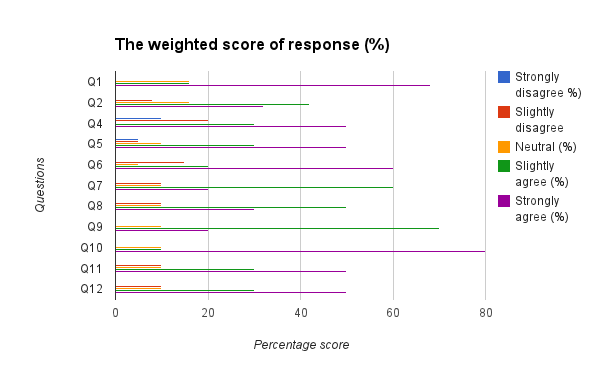
Objective 1 (Hypothesis 1)
The electronic word of mouth advertisement has an impact on consumer purchasing behavior among the Saudi Arabians
In this case, the various forms of relaying the electronic word-of-mouth advertisement will be measured against the various indicators for consumer purchasing power behavior among the Saudi Arabians. The table presented below shows the data collected.
The data in the table above indicates that out of the sample of 200 people who were interviewed, use of the electronic word-of-mouth advertisement induced an intake of products for 106 people. Further, it can be pointed out that electronic word-of-mouth advertisement results in an increase in the subscription rate, coverage rates, and purchase intentions among consumers. Finally, only 3% of the sample size indicated that the electronic word of mouth has no impact on their purchasing behavior. Thus, it can be deduced that advertisement has a positive impact on consumer purchasing patterns. Also, the use of sales is an effective way of estimating the relationship between electronic word-of-mouth advertisement and consumer purchasing behavior. Finally, rich media is the most effective way of relaying electronic word-of-mouth advertisements. The information in the table above can be displayed in a histogram as shown below.
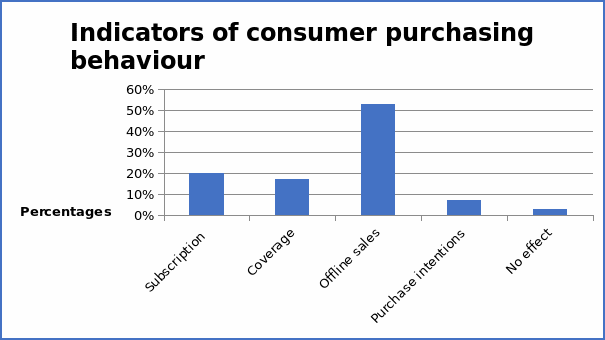
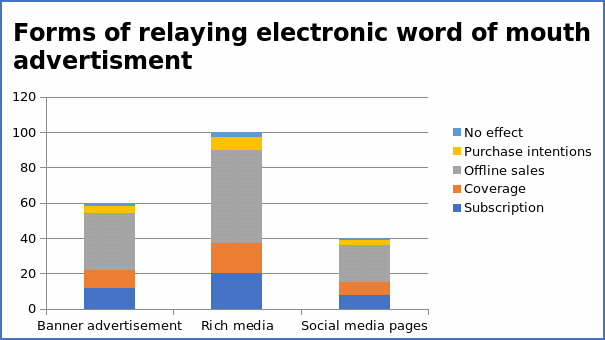
Objective 2 (Hypothesis 2)
There is a link between the level of product satisfaction and acceptance of electronic word-of-mouth communication
For this objective, a survey was conducted where customers were asked to give their opinion on whether electronic word-of-mouth advertisement increases the level of product satisfaction or not. The table presented below shows summary of data based on the survey conducted.
Based on the data in the table above, 166 respondents (slightly agree, agree, and strongly agree) acknowledged that electronic word-of-mouth advertisement increases the level of product visibility. 20 respondents disagree that electronic word-of-mouth advertisement increases the level of product satisfaction. Finally, 14 (neutral) were indifferent on whether electronic word-of-mouth advertisement increases the level of product visibility or not. Thus, it can be concluded that there is a positive relationship between electronic word-of-mouth advertisement and the level of product visibility.
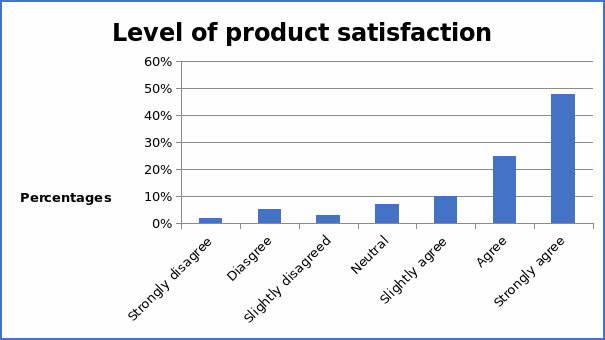
Objective 3 (Hypothesis 3)
There is a link between the type of method used to relay the electronic word-of-mouth advertisement and probability of purchase for such an item in Saudi Arabia
In this analysis, a chi-square test will be used to evaluate whether there is a difference between professionals and non-professionals in their preference for the method of relaying electronic word-of-mouth advertisement.
In the data above, it can be observed that the use of rich media is more appealing to the professionals and it results in a higher probability of purchase. Also, the use of banner advertisement is more appealing to the non-professionals and it results in a higher probability of purchase. Finally, 57% of the sample preferred rich media over banner advertisements. A chi-square test will be used to determine if there is a difference between the two methods of relaying advertisements. The null hypothesis is that there is no difference between professionals and non-professionals in their preference while the alternative hypothesis is that there is a difference between professionals and non-professionals in their preference on the method of relaying the electronic word-of-mouth advertisement. The results of the chi-square test is presented in the table below.
The value of significance (2-sided) of the Pearson chi-square test is greater than the value of alpha (0.05). Thus, the null hypothesis will be not be rejected and this implies that there is no difference between professionals and non-professionals in their preference of the two methods of relaying electronic word-of-mouth advertisement. Thus, even though the percentages calculated above indicates that there is a difference, the results of the chi-square test shows that the difference is not large enough to indicate that there is a difference in the population.
Objective 4 (Hypothesis 4)
Consumer purchasing behavior, as influenced by an electronic word-of-mouth communication, is dependent on the level of trust and knowledge customer has for the company selling a product
In this case, the consumer purchasing behavior will be measured using volume sales while the level of trust and knowledge will be estimated using the Likert scale. Values will be attached to the Likert scale as presented below. The table presented below shows a summary of the data.
A correlation analysis will be carried out to determine the degree of association between volume of sales and trust & the level of knowledge. A scatter plot diagram for the two variables is presented below.
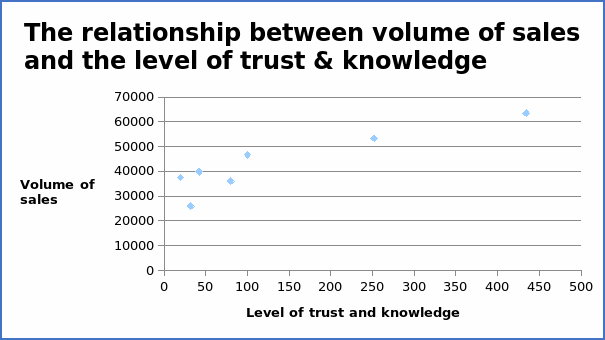
The points on the scatter diagram above tend to slope upwards. This gives an indication that the two points are positively related. The results of correlation analysis are presented below.
The results of correlation show that there is a strong positive association between trust and the level of knowledge and volume of sales. This implies that the level of sales (consumer purchasing behavior) will respond positively with the level of trust and knowledge a customer has for a company. A regression equation can be developed to estimate the relationship between the two variables. The results of the regression analysis are presented below.
From the results in the table above, the regression equation can be written as Y = 33191.16 + 73.43X. The slope is positive and it shows that there is a positive relationship between consumer purchasing behavior and the level of trust and knowledge a customer has for a company. The value of the R–square is 82.09%. It is favorable because it shows that level of trust and knowledge customer has for the company selling a product explains 82.09% of the variations in consumer purchasing behavior. This shows a strong relationship between the variables. Further, the value of t – t-calculated (4.7878) is greater than the value of t-critical (1.96) at the 95 % level of significance. This implies that the explanatory variable is a significant variable. In conclusion, the level of trust and knowledge customers has for the company selling a product has a strong positive influence on the consumer purchasing behavior, as influenced by an electronic word-of-mouth communication.
Summary of the Analysis
From the above results, it is apparent that most of the respondents had clear knowledge of the impact of electronic word of mouth on purchasing behavior in Saudi Arabia. Specifically, an average score of 80% was obtained for different questions that aimed to identify the success of electronic word of mouth as influenced by the clarity, reliability, and dependability of the communication on purchasing behavior. Emotion is positively related to consumer attitude. This is the general evaluation that consumers engage in before deciding to purchase a product. Reflectively, an electronic word-of-mouth message which appeals to the elements of emotion, attitude, and perceptions positively influences the customers’ purchasing behavior in Saudi Arabia. However, an electronic word-of-mouth message which does not appeal to the elements of emotion, attitude, and perceptions negatively influences the customers’ purchasing behavior in Saudi Arabia.
Discussion and Recommendations
The emotional perspective of consumer behavior represents an effective view on consumer behavior. For example, emotions are caused by exposure to a particular stimulus. Emotions and motivations often serve as the emerging forces within consumers that activate certain behaviors. Emotions are described as temporary states that show present changes in motivations whereas motivation are persistence need that stimulates long-term goals in consumers. These emotions control direct and indirect behavior inclinations that arouse the instinct to purchase or refuse to purchase. Though a temporary state of mind, emotions challenge the market preference and direct judgment to buy when cleverly incorporated in any electronic word-of-mouth communication.
Emotion is positively related to consumer attitude. This is the general evaluation that consumers engage in before deciding to purchase a product. Attitudes are direct personal experiences that are influenced by consumers’ personalities, advertisements, family, and friends. Perceptions are unique ways through which consumers internalize and interpret information about a product. Thus, Saudi Arabia should utilize advertising materials such electronic word of mouth to market different products and services since these behaviors have been proven to have a positive impact on consumers’ purchasing behavior. Given the literacy levels and the exposure to technological inventions of the target buyers, the group is likely to choose the products based on the psychological perception created by the electronic word-of-mouth advertisement.
Properly designed online marketing and product distribution management facilitated the success and sustainability of the electronic word of mouth since it operates within stipulated business laws. Among the new development elements that a company using the electronic word of mouth should incorporate in the segmented Saudi Arabia market include trust, distribution, fair retribution process, and passing accurate information to target audience to restore confidence within these networks. To sum up, Saudi Arabian online customers are provided, even bombarded, with a lot of information and communication messages that has changed their online behavior into a promiscuous and demanding user who is all-powerful in his or her choice.
Conclusion
Consumer behavior is a decision-making process and all activities that a potential customer is involved in prior to acquisition, evaluation, use, and disposition of goods and services. The consumer’s decision to purchase as influenced by electronic word of mouth is complicated, dynamic, multidimensional process as is the case in Saudi Arabia. Essentially, success of brand and product management as part of consumer behavior in Saudi Arabia will depend on a proper alignment of the company’s functional idea into the creation of flexible, involuntary, and quantifiable measurement of perception among the target customers. This is achievable through an effective electronic word-of-mouth platform.
Research timeline
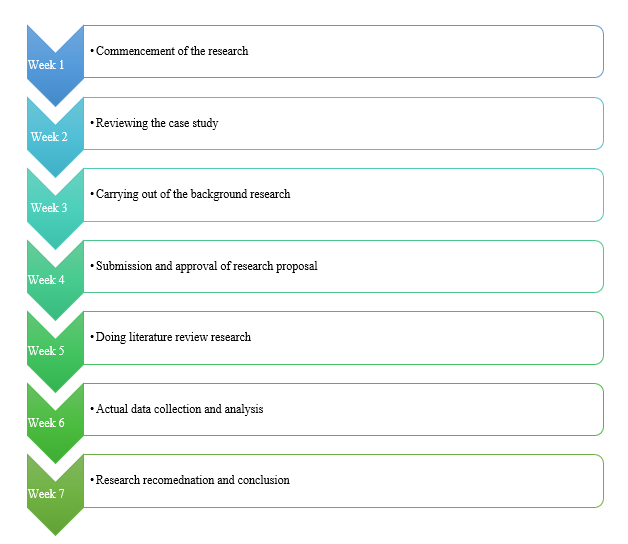
Works Cited
Almana, Amal and Ailsa Mirza. “The impact of electronic word of mouth on consumers’ purchasing decision.” International Journal of Computer Applications 82.9 (2013): 23-30. Print.
Gelb, Donald and Samantha Sundaram. “Adapting to ‘word of mouse.” Business Horizons 45.4 (2002): 21–25. Print.
Hennig-Thurau, Thorsten, Kevin Gwinner, Gianfranco Walsh, and Dwayne Gremler. “Electronic word-of-mouth via consumer-opinion platforms: What motivates consumers to articulate themselves on the internet?” Journal of interactive marketing 18.1(2004): 38-52. Print.
Khammash, Marwan, and H. Griffiths. “Electronic word-of-mouth (eWOM), antecedences and consequences”, International Journal of Information Management 31.3 (2011): 82-87. Print.
Stokes, Raymond. eMarketing: The essential guide to digital marketing, London, UK: Quirk eMarketing (Pty) Ltd, 2011. Print.
Weiss, Joseph. Business ethics: A stakeholder and issues management approach, Mason, OH: Cengage, 2008. Print.
Yin, Ronald. Case study research: Design and methods, Beverly Hills, CA: Sage, 2003. Print.